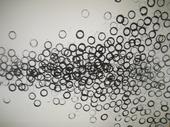As I continue taking opportunities, I am finding more and more the passions hidden within this art project. I got a chance to speak to a couple high school classes while back in the Black Hills. Doing so has strongly reinforced my belief that people are starving! for philosophy. The piece of my talk that students appeared to resonate fully with was a memory from my own childhood:
I believe I was about nine years old. My good friend, Annie, lived down the street that crossed the top of the small hill where I lived at the base. She and I were at the peak of the hill saying good-bye after hours of play outside. It was summer coming into fall. The twilight was fading and the lighting was surreal. The air felt warm and crisp simultaneously. As I waved good-bye, my own hand caught my eye. And it seemed strangely alien. As I brought it down, that feeling intensified and I called out to Annie. She turned back toward me and saw me staring at my hand. As she came up to me, I asked, “Does life ever feel weird to you? Like, what is this? What are we? What is going on?” And I explained how odd it felt to look at my hand and know it was “my hand”. She started to look at hers, too, and the same sensation came over her. We stood there staring at our own hands as the dusk gathered around us. Eventually, as we stood there wondering, the peculiar feeling began to fade. She and I parted ways, but that memory never has left me.
We are all thrust into existence and structures of living before we even have a consistent self-awareness. These structures of living are gifts from previous peoples; however, if all we are taught to perceive are the structures themselves, certain abilities of ours are neglected and suffering. These abilities never die, they are intrinsic to being human, but they can grow weak and we can begin to feel sluggish about life itself due to their neglect.
The first ability is our ability to reflect on the stunning act of being alive. The second is our ability to reflect on ourselves beneath our experiences and social and psychological shapings. We are life itself, each of us is a fingerprint of the universe, unique and sublime in our very existence. The third is our ability to sense the synergistic dynamic of everything that is. We are a perpetual spiral of webbing, everything is connected, nothing exists apart from the whole. My self-reflection thus can morph into a meditation on self as this one big Self that we are together, along with everything else on this planet.
Fourth, and I’ll make it my final, we may lose the ability to recognize that those structures into which we are thrust are not the real. The real is the canvas behind them, or the space, that allows them to take form in the first place. The real is what makes it possible to create, to shift, to change, to demolish and reconstruct. And this always is.
Imagination is our direct access to this space. Reason is one of the greatest sets of tinker toys we’ve ever devised to place our maps, our structures on this space. However, without the value of imagination, reason just might be mistaken to be the real. Seeing the world and ourselves through the lens of rational explanation necessarily makes an image, a picture, a symbol. If taken only in the literal, its greater potency is shut out from our awareness.
Philosophy and art help us to recognize and to exercise our ability to reflect beyond reason, to the hidden messages we are telling ourselves with our rational stories. They tell us how we feel, what we fear, and how we are coping with those fears. If we forget that our stories speak to us symbolically, even our rational stories, we blindly face crises when those rational stories change.
Why else would new stories such as Copernicus’ notion that the earth moved around the sun, not vice versa, or Darwin’s story that humans could trace our lineage as an evolution over time, sharing ancestry with other primates cause such outrage and call for such great adjustment as they did? Our daily lives weren’t directly impacted from these changes in belief. It’s not like suddenly other primates appeared at our family gatherings, or that we suddenly couldn’t walk a straight line due to the traveling earth. . .
These stories, all four, had spoken to us (and do speak to us) imaginatively. The stories carried (as all stories do!) symbolic significance that secretly informed us of ourselves, our fears, and how we were coping with those fears. Without recognition of the power of the symbolic knowledge that is carried along with literal, rational explanation, we simply fought the new stories. We could not believe them. We had lost connection to the role of imagination inherent within any creation, even the creation of our “truths”.
This art project begins where you are, where we all are, as children of the age of reason. We have learned how to use language literally, and how to explain rationally. But this art project is meant to move its viewers into the realm of imagination and symbol as well. It breaks language into pieces, sometimes in the middle of words, it makes it stutter, it repeats itself maniacally to make us all more aware of that which lies behind the structure of language and the structure of logical thought. May its viewers feel the rush of the fresh air released from the illusory lock-down from the perception that our current structures and maps are everything. Rather, they are images of ourselves, laden with secret knowledges that we are equipped to harvest and that will serve us as we continue to navigate the ever- swirl of existence. Promise.
